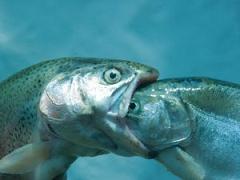Dynamic Architecture of Food Webs: Difference between revisions
From Santa Fe Institute Events Wiki
No edit summary |
No edit summary |
||
| Line 1: | Line 1: | ||
[[Image:fish.jpg]] | [[Image:fish.jpg]] | ||
We want to study the statistical properties of evolving networks (networks that change the number of nodes/connections/weights). What are the invariants? What properties change over time? | |||
We want to study | |||
For example, for dynamic food webs, a change may result from an adaptive modification of species diet in response to circumstance or the addition and extinction of species. We will look for the structural and dynamic effects of these mechanisms, including the formation of characteristic motifs and stabilization. | |||
For evolving gene regulatory networks, new regulatory units are created by duplications, destroyed by deletions, and the weights can change due to point mutations. ([[Borys]]) has built an artificial life platform (right now, it uses a genetic algorithm) that can generate a large number of gene regulatory networks that have evolved to perform certain computations (for example, process signals). I would be interested in investigating what are the statistical (or other) properties of these networks. | |||
Here is a paper that describes (a version) of the [http://www.alifexi.org/papers/ALIFExi_pp297-304.pdf model]. | |||
Revision as of 01:56, 11 June 2010
We want to study the statistical properties of evolving networks (networks that change the number of nodes/connections/weights). What are the invariants? What properties change over time?
For example, for dynamic food webs, a change may result from an adaptive modification of species diet in response to circumstance or the addition and extinction of species. We will look for the structural and dynamic effects of these mechanisms, including the formation of characteristic motifs and stabilization.
For evolving gene regulatory networks, new regulatory units are created by duplications, destroyed by deletions, and the weights can change due to point mutations. (Borys) has built an artificial life platform (right now, it uses a genetic algorithm) that can generate a large number of gene regulatory networks that have evolved to perform certain computations (for example, process signals). I would be interested in investigating what are the statistical (or other) properties of these networks.
Here is a paper that describes (a version) of the model.

